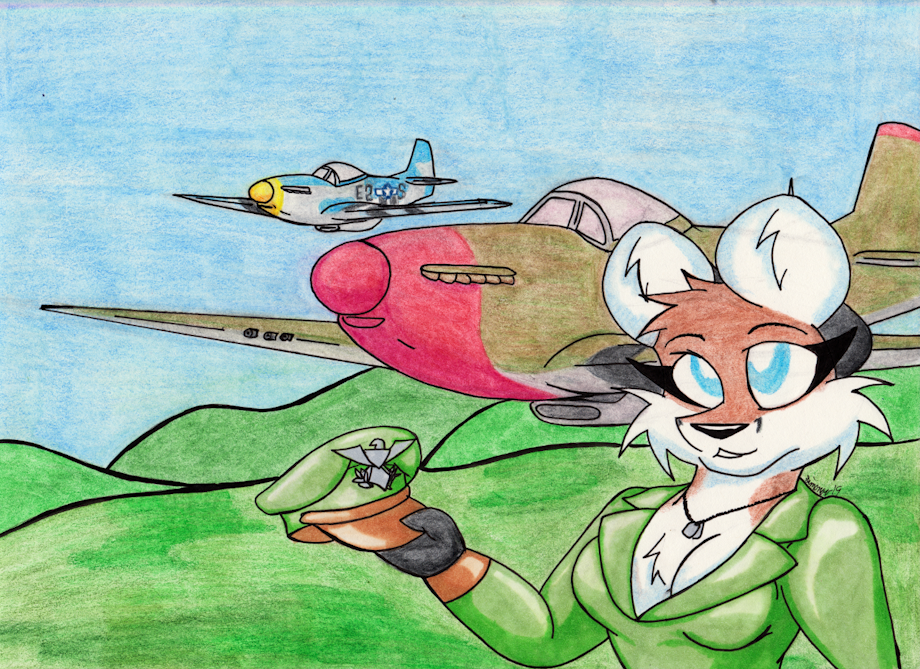Origin: USA
Year: 1943
Type: Pursuit, fighter
Weight: 7,635 lb (3,463 kg) empty
Height: 13 ft 4.5 in (4.077 m)
Wingspan: 37 ft (11 m)
Length: 32 ft 3 in (9.83 m)
Max speed: 440 mph (708 km/h)
Range: 1,650 mi (2,655 km) with external tanks
Ceiling: 41,900 ft (12,800 m)
Engine: 1x Packard V-1650 Merlin
Armament: 6x .50 cal. AN/M2 machine guns; 2x hardpoints capable of mounting external fuel tanks, 100 lb bombs, 250 lb bombs, 500 lbs bombs, and HVARs (High Velocity Aircraft Rocket)
Crew: 1
One of the most iconic fighter aircraft of World War II, the North American Aviation P-51D Mustang was one of the major fighter/pursuit aircraft types field by the US Army Air Force (USAAF) during the war. The P-51D addressed many of the shortcomings of early Mustang variants, including increased visibility for the pilot through the use of a bubble canopy and improved performance by exchanging the original Allison engine for a licensed copy of the Rolls Royce Merlin engine. Thanks to its range and performance, the Mustang proved to a formidable opponent for Luftwaffe fighters attempting to down Allied bombers attacking the Third Reich. An estimate of 4,950 enemy aircraft were claimed to have been destroyed by the Mustang in all of its variants, placing the type second only to the US Navy's Grumman F6F Hellcat for highest total number of enemy aircraft destroyed.
During the war, over 15,000 Mustangs were built by the US, 8,200 of which were P-51Ds and a further ~2,000 of the near-identical -H and -K models. A further 200 (80 built from NA kits and 120 licensed built) were built by the Commonwealth Aircraft Corporation for Australian service. The Mustang saw service not only with the US and Australia during the war but also with the United Kingdom, Canada, Nationalist China, France, South Africa, and Poland (operated by the Polish Air Force in Great Britain). The aircraft also saw extensive use after WWII, perhaps most notably as the F-51 and main fighter of United Nation's and US forces in the Korean War until the arrival of jet fighters such as the F-86 Sabre in larger numbers. Postwar users of the Mustang also include Switzerland, Uruguay, South Korea, the Philippines, Sweden, the Netherlands, Italy, Israel, the People's Republic of China (captured from Nationalist forces near the end of the Chinese Civil War) and El Salvador (one of which was lost in the last aerial combat between piston-engined fighters when it was shot down by a Honduran F4U Corsair in 1969). The last Mustangs in military service were finally retired in 1984 by the Dominican Republic.
The Mustang has also been popular in civil aviation, partaking in such events and activities as air shows, aerobatic demonstrations, and racing. Unlike many other warbirds of World War II, a significant number of P-51 Mustangs survive to this day with many in airworthy condition. Almost 300 Mustangs are believed to still exist with an estimated 170 still capable of flying.
Keywords
female
1,107,279,
fox
252,132,
vulpine
37,084,
pinup
32,037,
vixen
28,538,
latex
23,384,
red fox
9,190,
fighter
2,384,
airplane
1,268,
plane
1,116,
aircraft
404,
wwii
231,
aviation
171,
mustang
165,
us
143,
united states
121,
world war two
87,
armed anthros
34,
p-51 mustang
5,
p-51d
1,
north american aviation
1
Details
Published:
6 years ago
15 Jul 2019 03:12 CEST
Initial: 89a442e46cd33d34b5886303ee7a2862
Full Size: c8f3affbf18d0f8b993d0e48742db740
Large: 4d668d080b3d70eb4ebdadb8403b895f
Small: e17398380678bea61d598b5ea86419f1
Stats
35 views
9 favorites
3 comments
